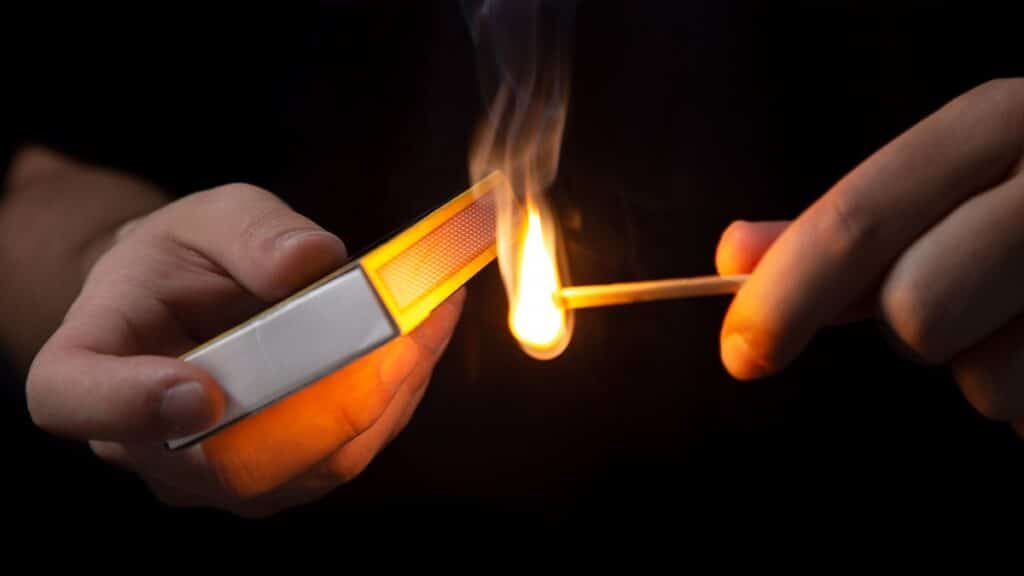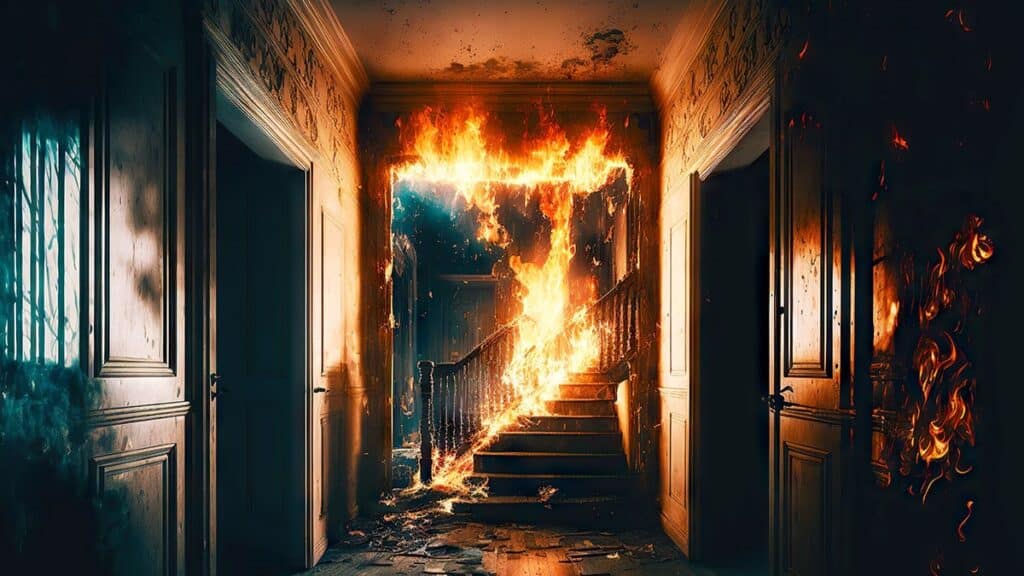Are you facing arson charges?
Dribbin & Brown Criminal Lawyers have handled hundreds of arson cases. If you have been charged, we can help you.
What is arson?
In Victoria, arson is a serious criminal offence, carrying a likely term of imprisonment if found guilty. Under section 197 of the Crimes Act 1958, three subsections address different forms of arson.
This page addresses arson causing criminal damage (destroying or damaging property) in sections 197(1) to 197(3).
If you have been charged with destroying or damaging property (not caused by fire), see ‘criminal damage‘.
Arson offences in Victoria
Several related but discrete offences address causing criminal damage (destroying or damaging property) by fire under section 197 of the Crimes Act 1958.
Arson causing criminal damage offences are:
- Arson causing criminal damage (s197(1))
- Arson causing criminal damage endangering life (s197(2))
- Arson causing criminal damage with a view to gain (s197(3))
A person guilty of arson is liable to level 4 imprisonment (15 years maximum).
The following are also arson offences, in surrounding provisions:
- Arson causing death (s197A)
- Intentionally or recklessly causing a bushfire (s201A).

Elements of arson
The prosecution must prove several elements, beyond reasonable doubt, for a jury to find an accused person guilty of arson under sections 197(1) to 197(3) of the Crimes Act 1958.
The elements of each offence are addressed separately below.
Arson causing criminal damage – s197(1)
To be convicted for ‘arson causing criminal damage’, the prosecution must prove the following elements:
- The accused damaged or destroyed property by fire;
- The property belonged to another person;
- The accused purposely damaged or destroyed the property, or knew or believed that damage or destruction was the likely result of their actions; and
- The accused had no lawful excuse for damaging or destroying the property.
Arson causing criminal damage endangering life – s197(2)
To be convicted for ‘arson causing criminal damage endangering life’, the prosecution must prove the following:
- The accused damaged or destroyed property by fire;
- The accused purposely damaged or destroyed the property, or knew or believed that damage or destruction was the likely result of their actions;
- The accused purposely endangered the life of another person through the damage or destruction of property or knew or believed that the life of another was likely to be endangered by that damage or destruction;
- The accused had no lawful excuse for damaging or destroying the property.
Arson causing criminal damage with a view to gain – s197(3)
To be convicted for ‘arson causing criminal damage with a view to gain’, the prosecution must prove the following elements beyond reasonable doubt:
- The accused damaged or destroyed property by fire;
- The accused did so dishonestly; and
- The accused did so with a view to gain.
Understanding the elements
Property, damage by fire and ownership
For these offences, property includes any real or tangible property (i.e. buildings, vehicles, etc.).
The Courts have considered the terms “destroy” and “damage” as follows:
- Destruction requires the property to be rendered useless for its intended purpose;
- Damage involves a permanent or temporary alteration to the physical integrity of the property – merely interfering with its use or operation is not sufficient (Grajewski v DPP [2019] HCA 8, [13]).
The prosecution is not required to establish specific ownership of the property, simply that a form of custody or right is held over the property by a legal entity (for example, a person, trust (s196(3)), or corporation (s196(4)).
Intention or purpose, knowledge and belief
The prosecution must prove that the accused had the required intention at the time of the relevant act or omission (Royall v R).
The requirement of intention, knowledge, or belief pertaining to the elements of ‘damage or destruction of property’, or ‘endangering of the life of another’, requires the specific intent, knowledge, or belief to do so by the use of fire (R v Cooper (G) and Cooper (Y) [1991] CLR 524).
An accused only intends to destroy or damage property if:
- One of the accused’s purposes is to destroy or damage property;
- The accused knows or believes that the conduct is more likely than not to result in destruction of or damage to property by fire (s197(4)).
An accused only intends to endanger the life of another person if:
- One of the accused’s purposes is to endanger the life of another by the damage or destruction by fire; or
- The accused knows or believes that the life of another is more likely than not to be endangered by the damage or destruction (s197(5)).
For the criminal damage offence of ‘arson endangering the life of another’ specifically, the intent relates to the danger caused by damage or destruction of property not danger caused by fire itself (R v Steer [1988] AC 111).
Section 197(4)(b) and 197(5)(b) of the Crimes Act 1958 extends the accused’s intent to include their knowledge or belief that it was more likely than not that the damage/destruction or life endangerment would result by their use of fire. In proving this, the prosecution need only prove that the defendant knew or believed it was more than 50% likely; this is comparable to similar tests for recklessness, which simply require a consequence be probable.
‘Dishonestly’ and ‘gain’
For the offence of ‘criminal damage with a view to gain, the prosecution must prove that the accused acted dishonestly (Crimes Act 1958 s197(3)).
This requires proof that the accused’s intent, knowledge, or belief about the damage or destruction caused made their conduct dishonest (Macleod v R).
‘Dishonesty’ adopts its regular meaning and is assessed according to the standards of an ordinary, decent person (Peters v R; Macleod v R).
In addition to acting dishonestly, the prosecution must prove that the accused acted with a view to gain, either for themselves or another (s197(3)).
‘Gain’ is interpreted generally and is not limited to monetary gain (DPP Reference (No 1 of 1988) [1989] VR 857). However, the view to gain must have existed at the time of the offending conduct.

Lawful excuse and defences to arson
The final element for criminal damage offences under section 197 is that the prosecution must prove that the accused acted without lawful excuse. Lawful excuses may arise in statute (or legislation) or common law.
There are two sets of defences which may be relevant, depending on the base offence (section 197(1), (2), or (3) of the Crimes Act 1958) as charged by the prosecution.
An accused may have a lawful excuse for a charge of ‘causing damage or property’ or ‘causing damage to property endangering life’ under the Crimes Act 1958 if they had a right or authority to damage the property or if they acted to protect the property.
Right or Authority to Destroy or Damage s201(2)(a) – The defendant must have honestly believed that:
- The property solely belonged to them; or
- They had some right or interest in the property that permitted them to cause the destruction or damage by fire; or
- They had, or would have, received consent from all necessary parties who could consent to the destruction or damage.
Protection of Property, Interest, or Right s201(2)(b) – The defendant must have:
- Acted to protect property either belonging to themselves or another, or to protect a right or interest in property that was, or they believed to be, vested in themselves or another.
Honestly believed the property, right, or interest was in immediate danger and that the conduct taken to protect property was reasonable given the circumstances.
Common law defences to charges under s197(1) to 197(3):
- Self-Defence: The defendant reasonably believed that causing the damage or destruction of property by fire was necessary to defend themselves.
- Consent: The defendant had consent from property owners to cause damage, destruction, or life endangerment.
Note this is a non-exhaustive list of defences that may be available in arson cases. For other defences, see our criminal law defences page.
Penalties for arson
Section 197(7) of the Crimes Act 1958 outlines a maximum penalty of 15 years imprisonment if found guilty of arson.
Regarding the average sentence handed down, it is important to note that the sentence of any given matter is entirely related to the circumstances of that case. Any averages provided are intended to only be a guide; if you wish for a more detailed assessment of your likely sentence, please contact us to arrange a consultation.
With this in mind, the Sentencing Council of Victoria found that, over the past five years from 2015-2016 to 2019-2020, the average length of imprisonment for cases of arson was 2 years and 4 months.
Where will my case be heard?
A charge of arson, depending on the damage caused, will typically be heard in the Magistrates Court, unless the value of property damage exceeds $100,000. In such instances, the charge may be heard in the County Court or the Supreme Court.
What should I do next?
Arson is a serious charge which can result in lengthy imprisonment if you are convicted. You should make an appointment with an arson lawyer as soon as possible to ensure proper representation and the best possible defence is provided for you.

























